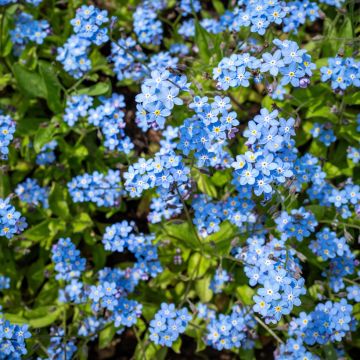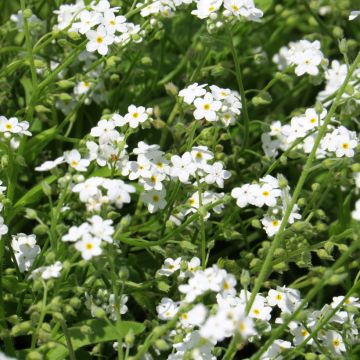

Myosotis sylvatica Victoria Azurea (Victoria Series) - seeds
Myosotis sylvatica Victoria Azurea (Victoria Series) - seeds
Myosotis sylvatica Victoria Azurea (Victoria Series)
Wood Forget-Me-Not, Woodland Forget-Me-Not, Wood Myosotis
Special offer!
Receive a €20 voucher for any order over €90 (excluding delivery costs, credit notes, and plastic-free options)!
1- Add your favorite plants to your cart.
2- Once you have reached €90, confirm your order (you can even choose the delivery date!).
3- As soon as your order is shipped, you will receive an email containing your voucher code, valid for 3 months (90 days).
Your voucher is unique and can only be used once, for any order with a minimum value of €20, excluding delivery costs.
Can be combined with other current offers, non-divisible and non-refundable.
Home or relay delivery (depending on size and destination)
Schedule delivery date,
and select date in basket
This plant carries a 6 months recovery warranty
More information
We guarantee the quality of our plants for a full growing cycle, and will replace at our expense any plant that fails to recover under normal climatic and planting conditions.
Would this plant suit my garden?
Set up your Plantfit profile →
Description
The Victoria Azurea woodland forget-me-not forms a compact and rounded clump of 20 cm in all directions. This biennial plant is ideal for dressing up a pot, as a border plant, or for forming a dense carpet of small blue flowers in spring. It pairs wonderfully with spring bulbs and other primroses. Easy to grow, Myosotis sylvatica thrives in moist, fertile, and well-drained soil, in partial shade or full sun. By sowing your seeds between June and early September, you will achieve flowering in the following spring.
From the Boraginaceae family, Myosotis sylvatica is a biennial plant, meaning it flowers the year following the sowing and then disappears. It is native to almost all of Europe, except for the far north and southwest, and grows naturally in meadows, clear undergrowth, and at the edge of forests. The 'Victoria Azurea' variety is appreciated for its small size, no more than 20 cm in all directions, and its profusion of flowers. It forms a small round cushion of small light green, slightly hairy leaf rosettes. From April to June, the plant is literally covered in small flowers, about 5 mm in diameter and intense blue. It often self-seeds naturally in the garden.
The Victoria Azurea Forget-Me-Not will find a place in all gardens, in a border to dress the base of perennials, in beds, rockeries, or even large pots or containers. It is an essential ally for your spring garden. Plus, it pairs wonderfully with spring-flowering bulbs like White Pearl Grape Hyacinth with white flowers and Tête Bouclée Daffodil with double lemon yellow flowers. Don't hesitate to associate it with Bellis perennis Tasso Strawberries and Cream daisies with pale pink flowers for a composition full of softness. The combination of yellow and blue is a spring must-have with the Belarina Buttercup Yellow Double Primrose!
Report an error about the product description
Flowering
Foliage
Plant habit
Botanical data
Myosotis
sylvatica
Victoria Azurea (Victoria Series)
Boraginaceae
Wood Forget-Me-Not, Woodland Forget-Me-Not, Wood Myosotis
Cultivar or hybrid
Other Forget-me-Not seeds
View all →Planting and care
Sow your Myosotis 'Victoria Azurea' between May and early September, ideally in a tray kept between 15 and 20 °C and choose a bright location. Place the seeds on the surface of moist, light and well-drained compost. Germination takes between 14 and 30 days. When the young plants have 5 to 6 leaves, you can transplant them into pots or in the garden. Late summer sowings can overwinter in a cool place to be planted in the ground from March, 20 to 30 cm apart.
In August, it is possible to sow directly in the ground, at a depth of 6 mm, in rows spaced 20 to 30 cm apart. Thin out to a distance of 20 cm, keeping only the most developed plants. Your Myosotis will bloom the following spring.
It is an easy plant to succeed with, which adapts to any soil with a preference for fertile, light, moist and well-drained soil. Partial shade or non-scorching sun suits it. As for maintenance, regularly remove faded flowers to prolong its flowering.
Sowing period
Intended location
Planting & care advice
This item has not been reviewed yet - be the first to leave a review about it.
Similar products
Haven't found what you were looking for?
Hardiness is the lowest winter temperature a plant can endure without suffering serious damage or even dying. However, hardiness is affected by location (a sheltered area, such as a patio), protection (winter cover) and soil type (hardiness is improved by well-drained soil).

Photo Sharing Terms & Conditions
In order to encourage gardeners to interact and share their experiences, Promesse de fleurs offers various media enabling content to be uploaded onto its Site - in particular via the ‘Photo sharing’ module.
The User agrees to refrain from:
- Posting any content that is illegal, prejudicial, insulting, racist, inciteful to hatred, revisionist, contrary to public decency, that infringes on privacy or on the privacy rights of third parties, in particular the publicity rights of persons and goods, intellectual property rights, or the right to privacy.
- Submitting content on behalf of a third party;
- Impersonate the identity of a third party and/or publish any personal information about a third party;
In general, the User undertakes to refrain from any unethical behaviour.
All Content (in particular text, comments, files, images, photos, videos, creative works, etc.), which may be subject to property or intellectual property rights, image or other private rights, shall remain the property of the User, subject to the limited rights granted by the terms of the licence granted by Promesse de fleurs as stated below. Users are at liberty to publish or not to publish such Content on the Site, notably via the ‘Photo Sharing’ facility, and accept that this Content shall be made public and freely accessible, notably on the Internet.
Users further acknowledge, undertake to have ,and guarantee that they hold all necessary rights and permissions to publish such material on the Site, in particular with regard to the legislation in force pertaining to any privacy, property, intellectual property, image, or contractual rights, or rights of any other nature. By publishing such Content on the Site, Users acknowledge accepting full liability as publishers of the Content within the meaning of the law, and grant Promesse de fleurs, free of charge, an inclusive, worldwide licence for the said Content for the entire duration of its publication, including all reproduction, representation, up/downloading, displaying, performing, transmission, and storage rights.
Users also grant permission for their name to be linked to the Content and accept that this link may not always be made available.
By engaging in posting material, Users consent to their Content becoming automatically accessible on the Internet, in particular on other sites and/or blogs and/or web pages of the Promesse de fleurs site, including in particular social pages and the Promesse de fleurs catalogue.
Users may secure the removal of entrusted content free of charge by issuing a simple request via our contact form.
The flowering period indicated on our website applies to countries and regions located in USDA zone 8 (France, the United Kingdom, Ireland, the Netherlands, etc.)
It will vary according to where you live:
- In zones 9 to 10 (Italy, Spain, Greece, etc.), flowering will occur about 2 to 4 weeks earlier.
- In zones 6 to 7 (Germany, Poland, Slovenia, and lower mountainous regions), flowering will be delayed by 2 to 3 weeks.
- In zone 5 (Central Europe, Scandinavia), blooming will be delayed by 3 to 5 weeks.
In temperate climates, pruning of spring-flowering shrubs (forsythia, spireas, etc.) should be done just after flowering.
Pruning of summer-flowering shrubs (Indian Lilac, Perovskia, etc.) can be done in winter or spring.
In cold regions as well as with frost-sensitive plants, avoid pruning too early when severe frosts may still occur.
The planting period indicated on our website applies to countries and regions located in USDA zone 8 (France, United Kingdom, Ireland, Netherlands).
It will vary according to where you live:
- In Mediterranean zones (Marseille, Madrid, Milan, etc.), autumn and winter are the best planting periods.
- In continental zones (Strasbourg, Munich, Vienna, etc.), delay planting by 2 to 3 weeks in spring and bring it forward by 2 to 4 weeks in autumn.
- In mountainous regions (the Alps, Pyrenees, Carpathians, etc.), it is best to plant in late spring (May-June) or late summer (August-September).
The harvesting period indicated on our website applies to countries and regions in USDA zone 8 (France, England, Ireland, the Netherlands).
In colder areas (Scandinavia, Poland, Austria...) fruit and vegetable harvests are likely to be delayed by 3-4 weeks.
In warmer areas (Italy, Spain, Greece, etc.), harvesting will probably take place earlier, depending on weather conditions.
The sowing periods indicated on our website apply to countries and regions within USDA Zone 8 (France, UK, Ireland, Netherlands).
In colder areas (Scandinavia, Poland, Austria...), delay any outdoor sowing by 3-4 weeks, or sow under glass.
In warmer climes (Italy, Spain, Greece, etc.), bring outdoor sowing forward by a few weeks.























































